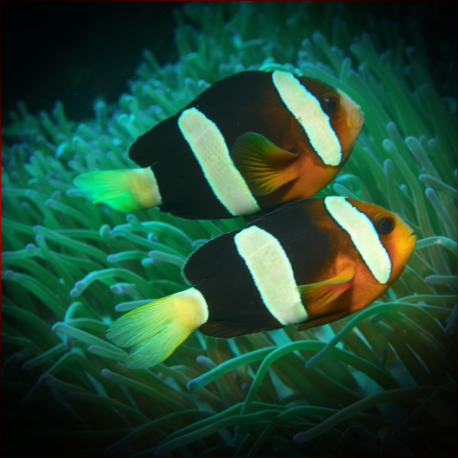More info
Datasheet
| Minimum Tank Size | 100 litres / 26.42 US gallons |
| Maximum Size | 10.0cm / 3.94inches |
| Reef Compatible | Always reef safe |
| Temperament | Might be aggressive towards similar species |
| Temperature | 22.2°C / 71.96°F - 25.6°C / 78.08°F |
| Specific Gravity | 1.020-1.025 |
| Carbonate Hardness | 8-12 |
| pH | 8.1-8.4 |
General Description
The Clarkii Clownfish, scientifically known as Amphiprion clarkii, belongs to the Pomacentridae family. These fish, commonly referred to as Yellowtail Clownfish or Clark's Anemonefish, can be found in the Indo-West Pacific region, from the Persian Gulf to Western Australia. They are distinguishable by their brown bodies with two wide white bands and a thin band at the caudal fin.
Aquarium Suitability
The Clarkii Clownfish is considered suitable for most aquarium setups. They are known to be hardy fish, adaptable to aquarium life, but can display aggression towards similar species, especially when it comes to defending their territory.
Care and Hardiness
These clownfish are hardy creatures, able to adapt well to aquarium conditions. They thrive in pairs, with the female typically being larger, and may exhibit territorial behavior towards their own species. They prefer to have their own space and can be aggressive towards most approaching fishes.
Reef Suitability
The Clarkii Clownfish is always considered reef-safe. They can be a good choice for reef aquariums but may display aggression towards other fish that encroach upon their territory.
Aquarium Setup
When setting up an aquarium for Clarkii Clownfish, it is important to provide them with hiding spots and potentially anemones as they tend to feel most secure in such environments. Maintaining water conditions with a pH level of 8.1-8.4, a specific gravity of 1.020-1.025, a temperature range of 22.2-25.6°C, and a carbonate hardness (KH) of 8-12 dKH is ideal for their well-being.
Behaviour
Clarkii Clownfish are known to exhibit territorial behavior and can be aggressive towards other fish that come too close to their hiding places. They typically form pairs, with fascinating social behaviors, especially when carrying eggs.
Feeding and Diet
Their recommended diet includes microalgae, small crustaceans such as krill and mysis, and zooplankton. Feeding them multiple times a day with a variety of foods ensures their nutritional needs are met in captivity.
Dimorphism
These fish are hermaphrodites, with the ability to change from male to female, where the female is typically larger in size. Captive breeding of the Clarkii Clownfish is possible, making them a sustainable choice for aquarium enthusiasts.
Habitat and Distribution
In the wild, Clarkii Clownfish are found in the East Indian Ocean, West Indian Ocean, Australia, Japan, and Indonesia. They are commonly associated with sea anemones but can adapt to other hiding spots in captivity, such as corals like Hammercoral or Xenia.

